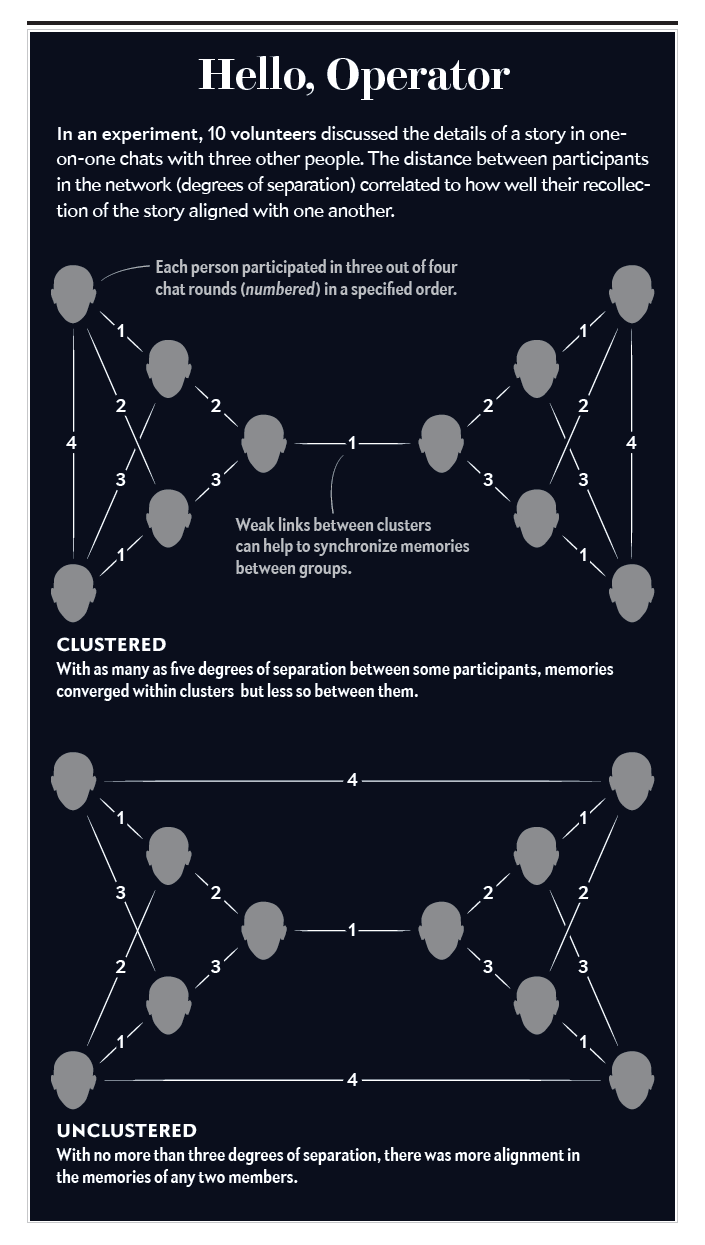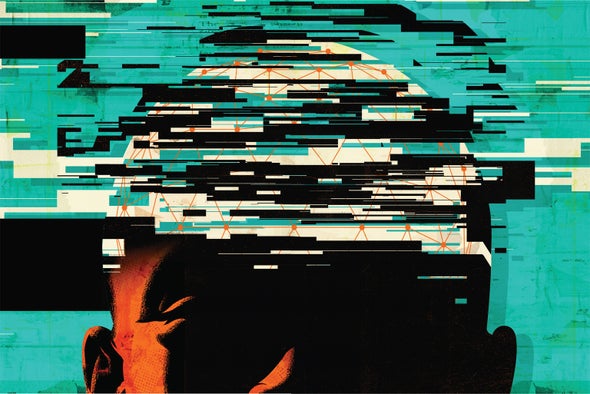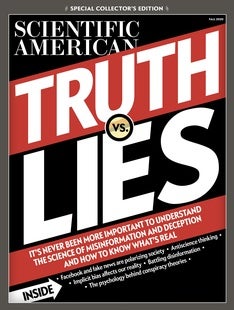Strange things have happened in the media in recent years. In 2017 members of the Trump administration alluded to a “Bowling Green massacre” and terror attacks in Sweden and Atlanta that never happened. The misinformation was swiftly corrected, but some historical myths have proved difficult to erase. Since at least 2010, for example, an online community has shared the apparently unshakable recollection of Nelson Mandela dying in prison in the 1980s, despite the fact that he lived until 2013, leaving prison in 1990 and going on to serve as South Africa’s first Black president.
Memory is notoriously fallible, but some experts worry that a new phenomenon is emerging. “Memories are shared among groups in novel ways through sites such as Facebook and Instagram, blurring the line between individual and collective memories,” says psychologist Daniel Schacter, who studies memory at Harvard University. “The development of Internet-based misinformation, such as well-publicized fake news sites, has the potential to distort individual and collective memories in disturbing ways.”
Collective memories form the basis of history, and people’s understanding of history shapes how they think about the future. The fictitious terrorist attacks, for example, were cited to justify a travel ban on the citizens of seven “countries of concern.” Although history has frequently been interpreted for political ends, psychologists are now investigating the fundamental processes by which collective memories form, to understand what makes them vulnerable to distortion. They show that social networks powerfully shape memory and that people need little prompting to conform to a majority recollection—even if it is wrong. Not all the findings are gloomy, however. Research is pointing to ways of dislodging false memories or preventing them from forming in the first place.
To combat the influence of fake news, says Micah Edelson, a memory researcher at the University of Zurich in Switzerland, “it’s important to understand not only the creation of these sites but also how people respond to them.”
All Together Now
Communication shapes memory. Research on pairs of people conversing about the past shows that a speaker can reinforce aspects of an event by selectively repeating them. That makes sense. Things that get mentioned get remembered—by both speaker and listener. There is a less obvious corollary: related information that goes unmentioned is more likely to fade than unrelated material, an effect known as retrieval-induced forgetting.
These cognitive, individual-level phenomena have been proposed as a mechanism for memory convergence—the process by which two or more people come to agree on what happened. But clues have emerged that group-level forces influence convergence, too. In 2015 psychologists Alin Coman of Princeton University and William Hirst of the New School for Social Research reported that a person experiences more induced forgetting when listening to someone in their own social group—a student at the same university, for example—than if they see that person as an outsider. That is, memory convergence is more likely to occur within social groups than between them—an important finding in light of survey data suggesting that 62 percent of U.S. adults get their news from social media, where group membership is often obvious and reinforced.
Groups can also distort memories. In 2011 Edelson, then at the Weizmann Institute of Science in Rehovot, Israel, showed 30 volunteers a documentary. They watched the film in groups of five and, a few days later, answered questions about it individually. One week after the viewing session, participants answered questions again—but only after seeing answers that members of their group had supposedly given. When most of the fabricated responses were false, participants conformed to the same false answer about 70 percent of the time—despite having initially responded correctly. But when they learned that the answers had been generated randomly, the participants reversed their incorrect answers only about 60 percent of the time. “We found that processes that happen during initial exposure to erroneous information make it more difficult to correct such influences later,” Edelson says.
Studying those processes as they happen—as collective memories are shaped through conversation—has been difficult to do in large groups. Years ago monitoring communication in groups of 10 or more would have required several rooms for private conversations, many research assistants and lots of time. Now multiple participants can interact digitally in real time. Coman’s group has developed a software platform that can track exchanges between volunteers in a series of timed chats. “It takes one research assistant 20 minutes and one lab room,” Coman says.
In 2016 the group used this software to ask, for the first time, how the structure of social networks affects the formation of collective memories in large groups. The researchers fed information about four fictional Peace Corps volunteers to 140 participants from Princeton University, divided into groups of 10. First, the participants were asked to recall as much information as they could on their own. Then they took part in a series of three conversations—online chat sessions lasting a few minutes each—with other members of their group, in which they recalled the information collaboratively. Finally, they tried to recall the events individually again.
The researchers investigated two scenarios—one in which the group formed two subclusters, with almost all conversations taking place within the subclusters, and one in which it formed one large cluster [see graphic below]. Although people in the single cluster agreed on the same set of information, Coman says, those in the two subclusters generally converged on different “facts” about the fictional volunteers.

This effect is evident in real-world situations. Palestinians living in Israel and those in the West Bank, who were separated by force during the Arab-Israeli wars of 1948 and 1967, have gravitated to different versions of their past, despite a shared Arab-Palestinian identity. Similarly divergent truths emerged after the erection of the Berlin Wall.
In the lab, Coman can manipulate social networks and look at the memories that form. His comparison of the two scenarios revealed the importance of “weak links” in information propagation. These are links between, rather than within, networks—acquaintances, say, rather than friends—and they help to synchronize the versions held by separate networks. “They are probably what drives the formation of community-wide collective memories,” he says.
One function of those weak links might be to remind people of information expunged through the processes of memory convergence. But timing is key. Coman has shown that information introduced by a weak link is much more likely to shape the network’s memory if it is introduced before its members talk among themselves. Once a network agrees on what happened, collective memory becomes relatively resistant to competing information.
Coman thinks that memory convergence bolsters group cohesion. “Now that we share a memory, we can have a stronger identity and might care more about each other,” he says. Abundant research links strong group identity with higher reported individual well-being. This is shown by research on the family. At Emory University, psychologist Robyn Fivush is studying the stories that families tell themselves. “What we find is that adolescents and young adults who know more family stories show better psychological well-being,” she says.
Although shared memories may foster more closely knit groups, they can also distort the role of outsiders, driving a wedge between groups. Memory shapes group identity, which in turn shapes memory, in a potentially vicious cycle. Weak links have an important corrective effect, but in their absence, two groups might converge on mutually incompatible versions of the past. These may be preserved for posterity in statues and history books. But they can evolve over time.
Making Memories, Making Histories
In Ostend, Belgium, a public monument depicts King Leopold II, surrounded by two groups of grateful subjects—one Belgian, the other Congolese. In 2004 protesters who felt that the monument misrepresented history severed the bronze hand of one of the Congolese figures. They explained anonymously to a local newspaper that the amputation more accurately reflected Leopold’s role in Belgium’s African colony: not genial protector but brutal tyrant.
In 2010 social psychologists Laurent Licata and Olivier Klein of the Free University of Brussels carried out a survey to explore different generations’ attitudes toward Belgium’s colonial past. They found that Belgian students expressed higher levels of collective guilt and support for reparative actions toward what is now the Democratic Republic of the Congo than did their parents, who in turn expressed higher levels than their parents. An important factor shaping that evolution, the researchers suggest, was Adam Hochschild’s influential book King Leopold’s Ghost (Houghton Mifflin, 1998), which painted a much darker picture of the colonial period than had been accepted previously. “Those who were young when that book came out were particularly marked by it,” Licata says, “whereas older Belgians had grown up with a different set of facts.”
Not all collective memories pass into history. Cognitive psychologists Norman Brown of the University of Alberta and Connie Svob of Columbia University have proposed that something besides cognitive and social processes determines whether an event survives the transition across generations: the nature of the event itself. “It is the amount of change to a person’s fabric of daily life that is most crucially at stake,” Svob says.
In a study published in 2016, they reported that the children of Croatians who had lived through the Yugoslav wars of the 1990s were more likely to recall their parents’ war-related experiences—getting shot, for example, or the house being bombed—than their non-war-related ones, such as marriage or birth of a first child. Wars, as with immigration, bring great upheaval in their wake and so are highly memorable, Svob says.
This “transition theory” she says, could also explain one of the biggest voids in Westerners’ collective memory of the 20th century—why they easily recall the two World Wars but not the flu pandemic of 1918–1920 that killed more than either of them (considering unrecorded deaths from the disease). “The degree of change wrought by war tends to be greater than the degree of change wrought by a pandemic,” Svob says. Others find that explanation puzzling: “If you lost a loved one in the flu epidemic,” Fivush says, “then it certainly disrupted your daily life.”
The set of collective memories that a group holds clearly evolves over time. One reason for this is that people tend to be marked most by events in their adolescence or young adulthood—a phenomenon known as the reminiscence bump. As a new generation grows up, events that happen to its members during their youth override the events that previously dominated society and thus “update” the collective memory. A 2016 survey by the Pew Research Center in Washington, D.C., showed that the defining historical moments for baby boomers in the U.S. were the terror attacks on September 11, 2001, and the assassination of President John F. Kennedy. For those born since 1965, they were the attacks on 9/11 and the 2008 election of President Barack Obama.
And over time each generation adds some events and forgets others. Psychologists Henry Roediger of Washington University in St. Louis and Andrew DeSoto of the Association for Psychological Science in Washington, D.C., report, for example, that successive U.S. generations forget their past presidents in a regular manner that can be described by a power function. They predict that Harry Truman (1945–1953) will be as forgotten by 2040 as William McKinley (1897–1901) is today.
That evolution is reflected by evolving attitudes toward the future. Roediger and anthropologist James Wertsch, also at Washington University, have observed that U.S. politicians debating the invasion of Iraq in the early 2000s fell into two groups: those who advocated invasion on the grounds that Saddam Hussein had to be stopped like Adolf Hitler before him and those who opposed it because they feared another bloody, protracted Vietnam War. Although each might have chosen their historical precedent for political reasons, they in turn reinforced that precedent in the memory of anyone who heard them speak.
Spotting the Fake
Research into collective memory has pointed to ways that it might be shaped for the collective good. Edelson and his team gave grounds for optimism when, in a 2014 follow-up to their earlier study, they reported that although some false memories are resistant to change, the people who hold them can nonetheless be influenced by credible information. The team used functional magnetic resonance imaging to scan volunteers’ brains as they recalled information about a film. The scans revealed changes in brain activation that correlated with the degree of confidence in an inaccurate memory—and, ultimately, with whether they reverted to their initial, accurate one. “By exposing them to the fact that this information is not credible, in most cases, individuals will take that into account,” Edelson says. “In 60 percent of cases, they will flip their answer. But even if they maintain a wrong answer, they’ll be less confident about it.”
Coman has two suggestions from his findings. The first is directed at the justice system. In some U.S. states, jurors are forbidden to take notes made during a trial into the deliberation room—a legacy of historically high illiteracy rates and a belief that the group remembers more reliably than the individual. In fact, Coman says, using notes could protect jurors from retrieval-induced biases and group-level social influences.
His second suggestion concerns the diffusion of crucial information to the public during emergencies such as epidemics. Having observed that retrieval-induced forgetting is enhanced in high-anxiety situations, Coman has come up with some advice for officials: draw up a short but comprehensive list of key points, make sure that all officials have the same list, repeat those points often and keep tabs on bad information that enters circulation. During the 2014 Ebola outbreak, for example, concerns in the U.S. were stoked by a misconception that being in the same room as a person with the infection was enough to catch it. The best way to kill that rumor, Coman says, would have been to explain—often—that Ebola can be transmitted only through bodily fluids. “If you understand the nature of the false information, you can target it for suppression just by mentioning information that is conceptually related but accurate,” he says.
Collective memory is a double-edged sword. Some will no doubt use it to mislead. “The fact that information can freely circulate in the community has been considered one of the most important and constructive features of open and democratic societies,” Coman says. “But creating such societies does not inherently guarantee positive outcomes.” False collective memories might be the price of defending free speech. But understanding how they form might offer some protection the next time people are reminded about a massacre that never happened.



